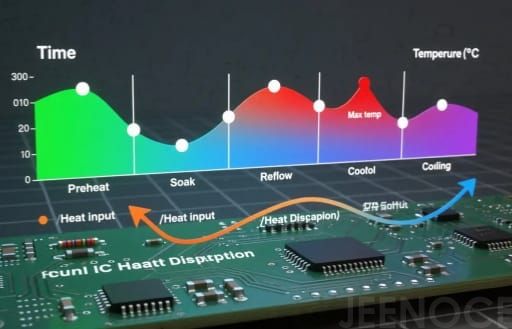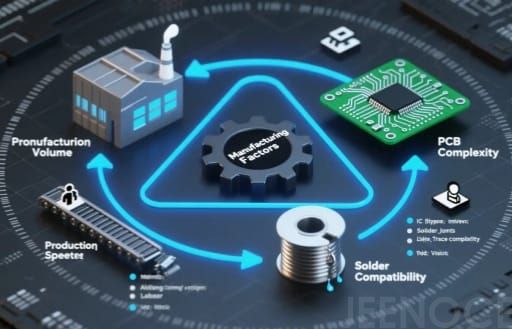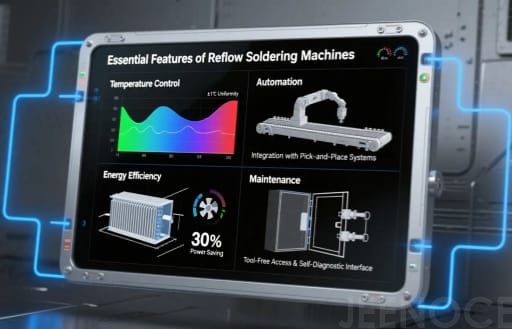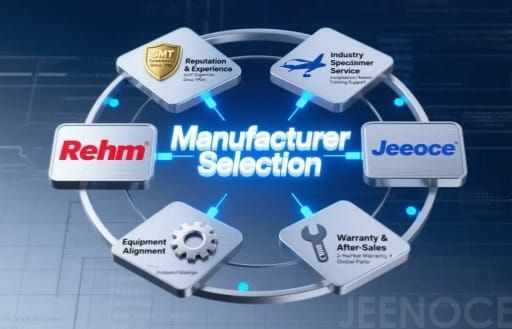Reflow soldering plays a pivotal role in electronic manufacturing by enabling the precise attachment of surface mount components to printed circuit boards (PCBs).
This process involves heating solder paste to melt and form reliable electrical and mechanical connections, ensuring the functionality and longevity of electronic devices.
It enables high-density assemblies that preclude manual soldering, reducing defects like voids or bridges while enhancing production efficiency.
Surface mount technology equipment—a core suite of tools for modern electronics production—includes reflow soldering machines, which facilitate this process by controlling heat transfer through predefined temperature profiles.
These machines heat the PCB assembly in a controlled chamber, allowing solder to flow evenly and create strong joints without damaging sensitive components.
This results in reliable solder joints critical for industries like consumer electronics, automotive, and aerospace, where equipment performance directly impacts end-product quality.

Low to Medium Volume: Desktop reflow ovens (priced ¥40,000–¥80,000) are ideal for prototyping or small batches. They fit well with compact PCB assembly equipment for small-scale production, and their compatibility with entry-level setups makes them a cost-effective choice for startups.
High Volume: Inline systems with conveyor speeds over 1.8 meters per minute and up to 12 heating zones handle 24/7 production. These pair with advanced tools, like high-speed pick-and-place machines, for seamless automated lines that minimize human error and boost output.
Choosing the Right Volume for Your Needs: “For startups or R&D, start with a desktop oven to save costs—its compatibility with basic setups keeps initial expenses low. For mass production, invest in inline systems to avoid bottlenecks, as they integrate smoothly with high-end SMT workflows.”
Board Size: For PCBs wider than 350 mm, choose large ovens with at least 6 heating zones. Smaller boards (under 350 mm) work with compact systems, saving space in workshops—ideal for facilities with limited floor area.
Thermal Sensitivity: Multi-zone PID control ensures temperature uniformity within ±1°C. This prevents warping or tombstoning on flexible or heavy-copper boards, aligning with the precision requirements of high-end setups used in automotive or aerospace component production.
Lead-Free Solders: These need higher temperatures (235°C–260°C) compared to leaded solders (205°C–215°C). Precise thermal profiling is essential to avoid material issues, as mismatched heating can disrupt the performance of other tools in the assembly line.
Cooling Methods: Nitrogen or water cooling reduces oxidation in Sn-Ag-Cu alloys. Air cooling works for basic Sn-Pb solders. Match cooling to your workflow for consistent results—e.g., nitrogen cooling pairs well with advanced machines used for lead-free, high-reliability projects.

Reflow soldering can be categorized into multiple classification frameworks.
Based on heating methods, it includes infrared, convection, infrared-convection hybrid, vapor phase, laser, and hot gas reflow soldering.
By equipment structure, options include tunnel-style, desktop, and vacuum reflow soldering systems.
Additional classifications, such as nitrogen-capable reflow ovens and microchannel reflow furnaces, further construct a comprehensive technical category framework—all of which are designed to integrate with different configurations of surface mount technology equipment.
These rely on forced hot air circulation for heat transfer, making them ideal for high-volume SMT production lines.
They ensure uniform board temperature, mitigating thermal gradients, and offer reliable soldering for complex components—making them a staple in large-scale production setups (e.g., consumer electronics manufacturing).
Utilizing radiation heating for rapid temperature ramp-up, these are suited for fast-paced processes prioritizing efficiency.
However, high-density boards require careful management of the“shadow effect”.While energy-efficient, they are less uniform in temperature compared to convection ovens, making them efficient yet precision-sensitive systems for quick-turn prototyping.
These use condensing vapor for oxygen-free soldering, ideal for sensitive components (e.g., aerospace-grade).
They reduce voids in solder joints, enhance reliability, and excel in energy efficiency and precise temperature control.
However, high equipment costs make them a premium solution for specialized applications, often paired with high-end tools in industries with strict quality standards.

To maximize performance, focus on these features:
Preheat, soak, reflow, and cooling zones ensure consistent joints. This aligns with other tools for quality soldering—e.g., precise preheating complements pick-and-place machines by preventing component damage during placement.
Integration with pick-and-place systems boosts efficiency in SMT production lines, a key advantage for workflows that prioritize speed and automation.
Insulated chambers and variable fan speeds cut power use while maintaining heat transfer—critical for setups that operate 24/7, as it reduces long-term operational costs.
Easy-access parts and gas cleaning systems ensure long-term reliability.
User-friendly interfaces simplify troubleshooting, minimizing downtime for equipment fleets.
Maintaining Your Reflow Oven: “Schedule regular cleaning of process gas systems to prevent downtime—this not only preserves oven performance but also protects other tools in your line from contamination-related issues. Check manufacturer guides for maintenance intervals.”

Opt for manufacturers with strong reputations and experience in SMT solutions.
For instance, companies like Rehm provide high-precision reflow ovens tailored for automotive and aerospace sectors, offering whole-line integrations with complementary tools.
Jeenoce (际诺斯), though less documented in global searches, is noted for similar high-end equipment that aligns with the performance needs of modern setups.
Recommended Reading: Top 10 Global Reflow Soldering Suppliers in 2025
Selecting a reflow soldering machine hinges on aligning throughput, PCB specifications, and sustainability.
High-yield facilities benefit from nitrogen-compatible inline ovens with ≥8 heating zones, while R&D labs may prioritize desktop units.
Partner with manufacturers offering lifecycle support—from thermal profiling to predictive maintenance—to safeguard solder joint integrity and ROI, ensuring your reflow oven integrates seamlessly with your surface mount technology equipment for long-term productivity.
A reflow soldering machine melts solder paste to attach components to PCBs via controlled heating phases: preheat, soak, reflow, and cooling. As a key part of surface mount technology equipment, it ensures precise joints without manual intervention, complementing other steps in PCB assembly.
Consider production volume, board complexity, and energy needs—convection for high-volume uniformity (ideal for large lines), IR for speed (suited for quick-turn setups), or vapor phase for oxygen-free precision (paired with high-end SMT tools).
Issues include tombstoning, bridging, voids, and cold joints from uneven heating or poor profiles. Prevention involves machines with accurate thermal control and uniform heat distribution—critical for maintaining consistency when paired with other tools.
It reduces operational costs and environmental impact while maintaining effective heat transfer, especially in high-volume setups where reflow ovens operate alongside energy-intensive equipment.
Reputable providers like Jeenoce typically offer consultation and maintenance services, including guidance on integrating reflow ovens with existing setups or building new SMT lines, alongside training for optimal selection and upkeep.
Message